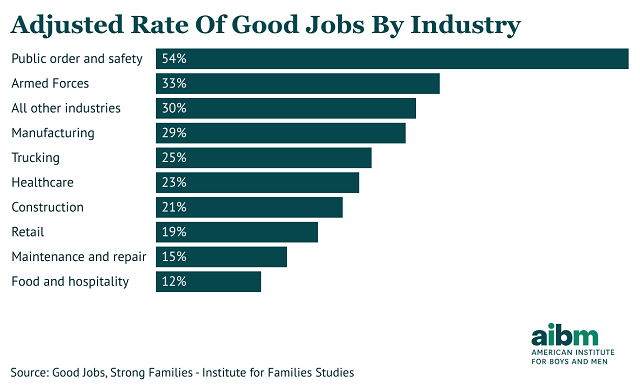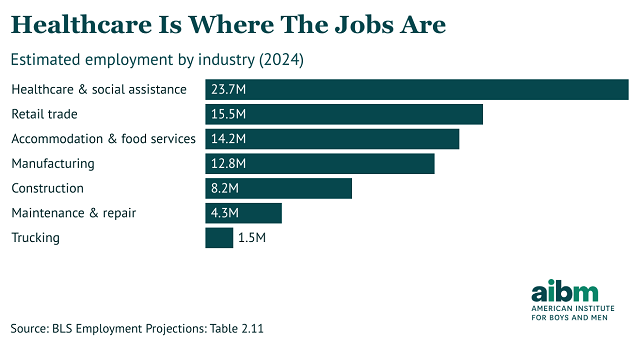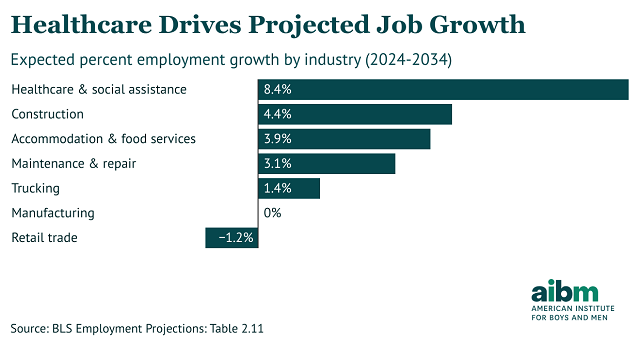Highlights
- Healthcare is where the jobs are. It is also where more of the jobs of the future are going to come from. Post This
- The idea that men in HEAL jobs are less likely than, say, construction workers to have the character traits for a good marriage lacks empirical grounding, and is baffling at best— reactionary at worst. Post This
- Martsolf worries that men may not see HEAL jobs as “masculine” enough. I think that is indeed a challenge. But surely a better question, from a marriage perspective, is what women think. Post This
Grant Martsolf and I are in strong agreement on a vital point: it would be good to encourage more men into the HEAL professions, especially healthcare and education. It would help these professions to fill vacancies, create a more representative workforce, and provide more job opportunities, including for working-class men. A win-win-win.
Liberal economist Paul Krugman joins us, writing recently: "What would a real solution to men’s economic problems look like? It wouldn’t involve trying to recreate an imaginary past when men had manly jobs and women knew their place."
Krugman continues:
What we can do is help men to take the jobs the 21st-century economy actually creates. Richard Reeves calls them HEAL occupations—health, education, administration and literacy. Many of these occupations are female-coded and have become more so over time, partly because they’re underpaid. But they don’t have to be.
They certainly do not. We need to break down the gender stereotypes preventing men entering these large, high-growth job sectors. Martsolf’s own field of nursing is case in point. As he has written in earlier work:
Nursing is uniquely positioned to help health care organizations but also improve the prospects of working-class men by welcoming more men into a college educational path that leads to a high-growth employment sector.
Martsolf shows that nurses out-earn those with similar levels of education, while offering a pathway for upward mobility: 35% of male registered nurses (and 30% of female registered nurses) have an associate’s degree as their highest level of education. But only 1 in 10 nurses are men, a share that Martsolf correctly says cannot plausibly be explained by innate sex differences in skills or interest.
But it’s not just nursing. There are a wide swath of jobs in the health and social care sector, as well as education, where men are woefully underrepresented. This is a huge missed opportunity to help men flourish in the changing labor market. Even when these jobs are not very highly paid (an issue I return to below), they are nonetheless good jobs in lots of ways.
Martsolf is also right that improving the economic prospects of men has a direct impact on marriage rates. His own earlier paper for IFS shows the class gap in marriage rates can largely be explained by the differences in the share of men with good jobs (defined by wages, stability, and benefits). Along similar lines, AIBM research by Clara Chambers, Benjamin Goldman, and Joseph Winkelmann finds that the class gap in marriage rates is cut in half when men from low-income backgrounds have higher employment rates,
So, HEAL sectors offer good job opportunities for working-class men; and when such men are working, they are more likely to be married. So what’s up with Martsolf arguing on these pages that “Getting more men into HEAL jobs won’t solve the working-class marriage crisis”?
Martsolf worries that men in HEAL won’t be husbands for four reasons.
- First, he says these jobs don’t pay well enough.
- Second, he argues they require too high a level of education.
- Third, he believes they do not code as “masculine” enough.
- Fourth, he worries they may not develop the character traits that would appeal to a potential spouse.
Some of these concerns seem reasonable. But none stand up to scrutiny. His focus is mostly on healthcare, so I follow suit here.
Do HEAL Jobs Pay Well Enough?
First, it is not at all clear that HEAL jobs are badly paid, at least compared to the alternatives. It is true that many HEAL jobs do not pull in big salaries. But the key question here is: compared to what? Nurses earn more than plumbers; social care workers make as much as construction workers; and nursing assistants do just as well as security guards.
Martsolf’s previous work here on work and marriage defines a “good wage” as $60,000 a year or more. By this standard, my own work with Ben Smith and Ravan Hawrami shows that most HEAL jobs have a good wage: the median wage for HEAL jobs is $64,000. Now, $64,000 is a lot less than the $102,000 median for STEM jobs. But it is a lot more than the $43,000 for other occupations.
Once education is taken into account, HEAL jobs look even better. For HEAL workers with an associate’s degree, the median wage is $73,000, compared to $64,000 for those in STEM fields and $51,000 in other sectors. If the concern is for men with less than a four-year college degree, then HEAL wages look pretty good.
As Martsolf points out, these jobs also tend to score highly in terms of job security, working conditions, and benefits. His earlier IFS paper shows the share of prime-age working-class male workers in good jobs by sector (based on all three characteristics of quality).

As the chart shows, the share of men working in healthcare who have good jobs is lower than in other sectors, certainly, but not by very much. And it is higher than for construction and maintenance workers. You might look at the chart above and conclude that a guy with a college degree should get a job as a cop or soldier. But the challenge here is one of raw numbers.
Where the Jobs Are
Here are the same occupational categories ranked by size:1

There just aren’t that many cops and soldiers. Healthcare is where the jobs are. It is also where more of the jobs of the future are going to come from. Here are the same sectors (minus the military) ranked by expected growth rates from 2024 to 2034:

The math is clear. HEAL is where the jobs are, and where they’re coming from. Many pay pretty well, certainly by comparison to likely alternatives, and offer decent security and benefits. It is better to deal with the world as it is, rather than as we might wish it to be.
Education and HEAL
Martsolf’s second concern is that HEAL jobs require too much education to pay off. It is certainly true that HEAL jobs requiring no more than a high school diploma, such as home health and personal care aides, do not pay as well. But that’s true of almost all jobs at this education level, not just HEAL ones. And as he points out, the HEAL jobs with the highest marriage rates for working-class men require some college, but not a bachelor’s degree: paramedics and radiation technologists, for example. This may be the sweet spot for attracting men into HEAL jobs.
Martsolf worries that men may not see HEAL jobs as 'masculine' enough. I think that is indeed a challenge. But surely a better question from a marriage perspective is what women think.
Are HEAL Jobs 'Masculine' Enough?
Third, Martsolf is concerned that HEAL jobs might not be manly enough for the marriage market. "Cultural identity, gender norms, and the social meanings attached to certain kinds of work may also influence family formation," he writes. "Some HEAL jobs may be seen by some men as more or less compatible with their notions of masculinity and family provision."
This is an intriguing question, which it is necessarily hard to get at empirically. But Martsolf has conflated notions of masculinity with “family provision” too quickly here. In most families today, both parents work, sharing the providing between them. If the unspoken thought here is that working-class men need a job paying well enough to support families with no economic input from their wives, that’s a whole different story.
Martsolf also worries that men themselves may not see these jobs as “masculine” enough. I think that is indeed a challenge here. But surely a better question, from a marriage perspective, is what women think. Here, I think Martsolf’s own data is encouraging. In his Table 2, he points out high rates of marriage among working-class men who are paramedics or priests (60% and 59%, respectively). But he also shows that among the 10 highest-ranked HEAL jobs in terms of male marriage rates are nurses (49%) and massage therapists (45%). When male masseurs are among those most likely to be married, it is hard to argue that cultural factors about masculinity and jobs are a big factor here.
What About Character?
Finally, building on his earlier work, Marsolf is concerned that HEAL jobs may not cultivate “character virtues aligned with family life—such as dependability, responsibility, and service to others.” He goes on to argue that "we must not overlook jobs that offer the structure and environment needed to cultivate the kind of character that also leads to success related to marriage and family. Some HEAL roles may meet this standard—but many likely do not."
Here I think his worry is entirely misplaced, and indeed counterproductive. The claim that jobs in healthcare and education do not reward and reflect “dependability, responsibility, and service to others” strikes me as completely wrong. The opposite is more likely to be true. Think about nurses or teachers, and the “structure and environment” of their workplaces. Surely these are precisely the kind of jobs that demonstrate and develop the qualities Martsolf is looking for. The idea that men working in HEAL jobs are less likely than those in, say, construction or manufacturing, to have the character traits for a good marriage lacks empirical grounding, and is baffling at best, reactionary at worst.
More Husbands, More HEAL
Martsolf is correct, however, that “cultural identity, gender norms, and the social meanings attached to certain kinds of work may also influence family formation.” So our goal here must be to lift HEAL professions up as aspirational ones for men, especially for working-class men. He is also right that improving pay and career opportunities in some of these occupations is an important step towards recruiting more men. The cultural challenge, as Martsolf has argued elsewhere with regard to nursing, is to work to “decode” the gendered cultural perception of these roles as feminine ones.
Of course, Martsolf is right that this will be “no panacea” when it comes to marriage and family formation. But what is? The evidence suggests that men’s employment prospects matter greatly for their chances of forming a family, and that the labor market is shifting towards HEAL jobs. If we want more husbands, we need more men in HEAL.
Richard V. Reeves is the founding president of the American Institute for Boys and Men (AIBM). He is also a nonresident senior fellow at the Brookings Institution, where he previously held the John C. and Nancy D. Whitehead Chair in Economic Studies.
1. Figures 2 and 3 are from BLS Employment Projections, 2024-2034, Table 2.11. We use NAICS-based series: Manufacturing 31–33, Retail 44–45, Construction 23, Health care & social assistance 620000, Accommodation & food services 720000, Trucking 484000, and a Maintenance & repair aggregate (811000 + 561700 + 562000). Relative to Martsolf’s IND-coded microdata, Manufacturing, Retail, Construction, and Trucking are 1:1 matches under the official 2022 Census IND-NAICS crosswalks. Our “healthcare and social assistance” category does not include federal hospital staff, while Martsolf does. “Food service” corresponds to NAICS 72, and so is narrower than Martsolf’s IND bucket as ours excludes Arts/Entertainment. We exclude “public order & safety” and “armed forces” because the BLS employment projections do not publish standalone NAICS 922 or an armed-forces industry series.
Photo credit: Shutterstock













